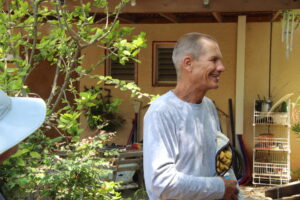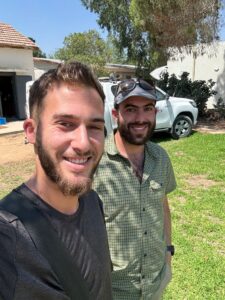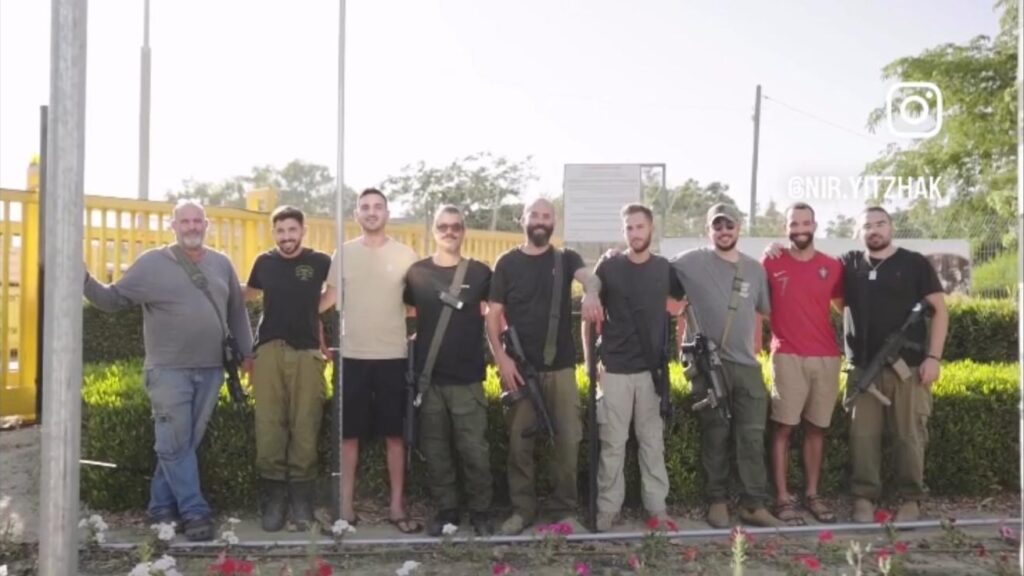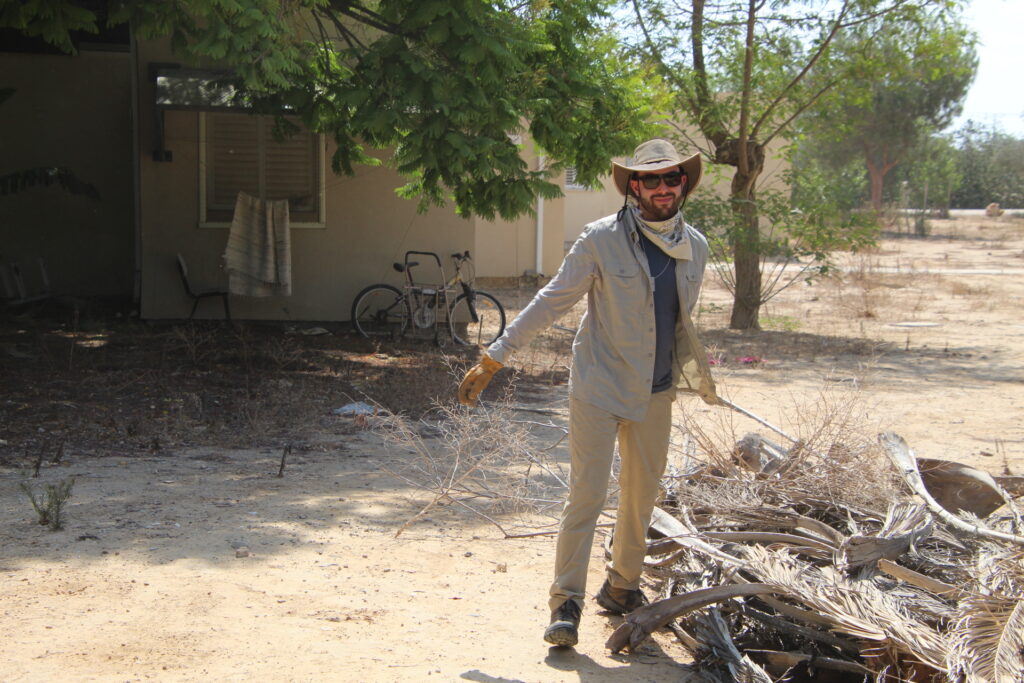Stepping up for Israel
What does it mean to “step up for Israel”?
Photo: Sami Rahamim helps clear brush at Kibbutz Holit as part of Minneapolis Jewish Federation’s Tikvatenu II Volunteer & Solidarity Mission on July 2, 2024.
By Sami Rahamim, Director of Communications and Community Affairs
August 9, 2024
The Hebrew word Yisrael carries three distinct meanings: Eretz Yisrael (Land of Israel), Medinat Yisrael (State of Israel), and Am Yisrael (People of Israel).
I recently returned from 24 remarkable days in Israel. Breathing the air of Eretz Yisrael, wrestling with the complex and contradictory realities of Medinat Yisrael, and connecting with the beauty, diversity, pain, and resolve of Am Yisrael was exactly the medicine I needed.
I am honored to share two (of many) stories that inspired me this trip, of individuals who have stepped up for their communities – for Israel – and whose courage and leadership should inspire us all.
***
My visit began with 24 other members of our beloved community on Minneapolis Jewish Federation’s Tikvatenu II Volunteer & Solidarity Mission.
On our first full day in Israel, our group made the strange and haunting “pilgrimage” to Otef Azza (the Gaza Envelope), the cluster of Israeli towns, villages, kibbutzim, and moshavim which were invaded by Hamas terrorists on October 7th.
After traveling the length of the now-infamous Route 232 (which Hamas turned into a corridor of terror that Shabbat/Simhat Torah morning) our first stop was at Kibbutz Holit, a small Kibbutz near the Kerem Shalom Crossing into Gaza. Our community is now connected to Holit because some of its residents are displaced in Rehovot, Minneapolis’ partnership city.
My fellow trip participant and JCRC Vice President, Jacy Grais, wrote poignantly about our volunteer effort to clean up the Kibbutz gardens, which appeared untouched for nine months:
The Holit gardens, overgrown with weeds, told stories of their own suffering in a way that only nature can. As helpless as I’ve been feeling, pulling weeds with our group to clean the gardens felt productive and therapeutic; using supplies provided to Holit by MJF made it all the more meaningful. In talking to the few residents who have returned, I felt sure that the entire Kibbutz – people, gardens, buildings, will again thrive; its residents are resolute that it must, and Minneapolis gets to be part of that story.

At Holit, we met two extraordinary individuals: Shachar and Nitzan. Shachar, a member of the kibbutz Kitat Konnenut (civilian readiness squad), was off the kibbutz on October 7 but is now one of the few residents who have returned.
Nitzan introduced himself as the kibbutz “garden boy” — but he is much more than that. Nitzan grew up on this kibbutz as the child of Holocaust survivors.
On the morning of October 7, as he watched terrorists invade the Kibbutz from his kitchen window, Nitzan made the split-second decision to dart out the back door. He climbed up to the flat roof above his bomb shelter and laid still for 12 hours until the army cleared the Kibbutz.
Upon being asked what he felt while hiding those torturous hours, Nitzan’s response was instant, as if it were obvious:
“Shoah!”
And yet, here he was — smiling, grateful to be alive and for the opportunity to step up.
Before the massacre, Nitzan was not the Kibbutz “garden boy.” For 35 years, he practiced Chinese Medicine. But his friend, the man responsible for the Kibbutz landscape and orchards, was one of 15 Holit residents – nearly 10% of the Kibbutz – who were murdered that fateful morning. Nitzan stepped up for his friend, for his Kibbutz, for Israel.
***
Barely a mile to the northeast of Kibbutz Holit sits Kibbutz Nir Yitzhak. Three weeks after our group visited and volunteered on Holit (and two weeks after the Tikvatenu group had returned to Minneapolis), I rented a car and drove that same scarred road 232 down to Nir Yitzhak to visit Minnesota-native Ben Ribnick.

Though we both grew up at Beth El Synagogue and are only four years apart, I first met Ben when he spoke on October 10, 2023, at our Community Gathering in Solidarity with Israel at Beth El.
At the gathering, Ben shared testimony of the Donana family, who took special care of him for the 18 months he lived on Nir Yitzhak during his army service as part of the Garin Tzabar program (which places cohorts of lone soldiers – IDF volunteers from around the world without family in Israel – to live on kibbutzim during their time away from the army).
Ben was released from his IDF service just two months prior to October 7, and he flew home to start what he believed would be his next chapter in the U.S.
But as Ben said at Beth El, “I now know my service is far from over.”
By February, Ben was back in Israel and, in May, brought himself full circle to serve as RavShatz (head of the civilian readiness squad) at Kibbutz Nir Yitzhak.
In that role, Ben leads a multigenerational team of 13 kibbutz residents who are trained and equipped to respond to attacks at Nir Yitzhak, along with 13 young IDF reservists who are helping prepare the kibbutz for the return of residents who have been evacuated/displaced since October.

These are hopeful days at the Kibbutz. While only 60 of the roughly 600 kibbutz residents have returned so far, Nir Yitzhak is expecting some 400 to return in the coming month. The Kibbutz pool is being filled next week. Animals will return to the petting zoo.
Ben reports something “magical” is happening in the Otef: Young Israelis have flocked to kibbutzim like Nir Yitzhak to help rebuild hard-hit, traumatized communities in the Zionist spirit of Israel’s pioneers.
I can’t think of a more meaningful way to step up for Eretz, Medinat, and Am Yisrael all in the same moment.
***
As Ben and I reflected on the challenges our homes (Minnesota and Israel) are each facing, we both felt grateful that we have opportunities to step up for Israel.
Here are three suggestions:
- Visit Israel: It’s never been truer that there is no substitute for travelling to Israel to understand the complex and contradictory realities of this miraculous place.
- Donate: Support communities like Holit and Nir Yitzhak by donating to the Israel Emergency Fund of Minneapolis Jewish Federation or St. Paul Jewish Federation.
- Engage locally: At JCRC, we believe that each of us has a role to play in strengthening the Jewish people and combatting antisemitism. We must engage with civic life, especially outside the confines of the Jewish community, to tell Israel’s and our story during this fraught moment.
How will you step up for the land, the country, and the people of Israel?
This blog post was the featured staff column for the August 2024 Gesher (‘Bridge’ in Hebrew) – JCRC’s monthly email newsletter.
Subscribe
###
As the consensus public affairs voice of the Jewish community, JCRC builds relationships to fight antisemitism and bigotry; educates about Judaism, Israel, antisemitism, and the Holocaust; advocates for Jewish values and priorities; and safeguards our community.


